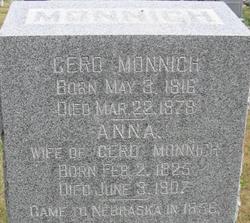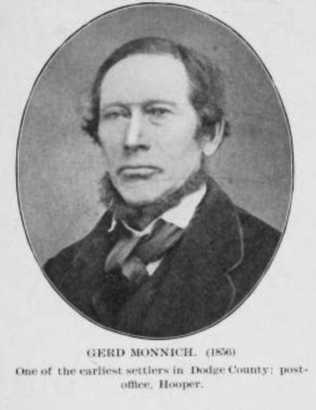March 1, 1900
The First Settlers
A Little Biography and History of Some of the Early Pioneers
(Paper No. 1)
In a brief sketch of some of the early pioneers of this vicinity it is not intended to write any thing like a general history. In the space allotted this could not be done while to make anything like an authentic account would require much more time than we can give the subject now. What historical facts may be inserted are not to be considered only as having an indirect bearing on the sketches that may be presented.
Take the town of Hooper as a center and go in any
direction you will, and the landscape is dotted over with fine farms brought to a high state of cultivation, comfortable buildings, many of them beautiful, attest to the industry of the owners. But this was not always the case. Less than a half century ago this country was simply known as part of the Great American desert and the possibility that this great state of Nebraska could ever be made to support a population of millions of people was not thought of by the most enthusiastic boomer.
Statistics show how far from correct was the popular belief.
The credit of this is due in no small measure to the pioneers and it is of their early struggles we wish to write.
No attempt was made to settle the country prior to the
year 1854 although there had been straggling settlements along the Missouri river induced by the travel to California. A few cattleman used the country for grazing purposes, but no farms were opened in this vicinity until about 1857. And so far as our information goes Gerhard Monnich and Gerhard Munderloh with their families were the first white settlers to plant their takes and declare for a permanent residence in what is now Everett Township and at the time was a part of Washington county. They were followed the next year by George Weigle and John Roggensack and their families.
Gerhard Monnich was born in Germany and came to the United States in the year 1854 settling first in Illinois, where he remained a short time. Lived in Iowa 2 years when he removed to Cuming City, Nebr., and came to what is now Dodge county in the spring of 1857, and located on S. W. 1/4 of section 1 town 19. At this time the nearest white settlement was at DeWittt and the nearest neighbor was a man by the name of Leister, distant 15 miles. Indians resented the encroachments of the whites and
in June 1858 compelled them to leave their homes but they
returned as soon as the scare was over. At the time of coming to Nebraska Mr. Monnich's family consisted of himself, wife and two children, Mary, now married to M. Von Seggern, and Herman.
Between the Indians and drouth it was an uphill drag but with indomitable pluck and a confidence in the country he persevered and before his death, which occurred in 1878, he
had the satisfaction of knowing that his judgement had been
approved and the country even then and been "made to blossom as the rose." His widow and five children survive him. Herman and John are still living on the old place, or rather the old place with what had been added amounting in all to 960 acres. Bernard engaged in the real estate business and also postmaster at Hooper, Dora the wife of Casper Heller, and Mrs. Von Seggern of Wisner. In the year '57 crops were almost a total failure and the family were compelled to live on corn bread for breakfast,
corn bread for dinner and corn bread for supper and all had to be ground in an ordinary coffee mill. The nearest mill was Fort Calhoun, 40 miles distant. The nearest market was Omaha and it took a good week to make the round trip with an ox team. When
he first came here the government had not completed the survey of the land but in the summer of 1857 it was thrown open to settlement and the surveys made. Before this all land occupied was simply taken by what was alled "squatters right."
Buildings in those days were very primitive affairs. Being close to timber Mr. Monnich's first house was built of logs and slough grass being abundant the roof was put on with that. After the government had
completed its survey the land was filed on and by paying $1.25 an acre a patent could be obtained. Afterward the homestead and timber acts allowed actual settlers to increase their holdings. This Mr. Monnich did and this
was represented in his farm of 960 acres. For years no streams were bridged and when a trip to mill or market became an absolute necessity it was ford or swim. During the grasshopper years it almost came to a show down as to whether the "hoppers" were to take the country or the settlers, but by dint of hard work and much pinching the settlers worried through.
Many interesting items could be told of the trials of Mr. Monnich and his family in their endeavors to make a home for themselves but as this will necessarily follow in other papers it well be omitted here.
March 1, 1900
The First Settlers
A Little Biography and History of Some of the Early Pioneers
(Paper No. 1)
In a brief sketch of some of the early pioneers of this vicinity it is not intended to write any thing like a general history. In the space allotted this could not be done while to make anything like an authentic account would require much more time than we can give the subject now. What historical facts may be inserted are not to be considered only as having an indirect bearing on the sketches that may be presented.
Take the town of Hooper as a center and go in any
direction you will, and the landscape is dotted over with fine farms brought to a high state of cultivation, comfortable buildings, many of them beautiful, attest to the industry of the owners. But this was not always the case. Less than a half century ago this country was simply known as part of the Great American desert and the possibility that this great state of Nebraska could ever be made to support a population of millions of people was not thought of by the most enthusiastic boomer.
Statistics show how far from correct was the popular belief.
The credit of this is due in no small measure to the pioneers and it is of their early struggles we wish to write.
No attempt was made to settle the country prior to the
year 1854 although there had been straggling settlements along the Missouri river induced by the travel to California. A few cattleman used the country for grazing purposes, but no farms were opened in this vicinity until about 1857. And so far as our information goes Gerhard Monnich and Gerhard Munderloh with their families were the first white settlers to plant their takes and declare for a permanent residence in what is now Everett Township and at the time was a part of Washington county. They were followed the next year by George Weigle and John Roggensack and their families.
Gerhard Monnich was born in Germany and came to the United States in the year 1854 settling first in Illinois, where he remained a short time. Lived in Iowa 2 years when he removed to Cuming City, Nebr., and came to what is now Dodge county in the spring of 1857, and located on S. W. 1/4 of section 1 town 19. At this time the nearest white settlement was at DeWittt and the nearest neighbor was a man by the name of Leister, distant 15 miles. Indians resented the encroachments of the whites and
in June 1858 compelled them to leave their homes but they
returned as soon as the scare was over. At the time of coming to Nebraska Mr. Monnich's family consisted of himself, wife and two children, Mary, now married to M. Von Seggern, and Herman.
Between the Indians and drouth it was an uphill drag but with indomitable pluck and a confidence in the country he persevered and before his death, which occurred in 1878, he
had the satisfaction of knowing that his judgement had been
approved and the country even then and been "made to blossom as the rose." His widow and five children survive him. Herman and John are still living on the old place, or rather the old place with what had been added amounting in all to 960 acres. Bernard engaged in the real estate business and also postmaster at Hooper, Dora the wife of Casper Heller, and Mrs. Von Seggern of Wisner. In the year '57 crops were almost a total failure and the family were compelled to live on corn bread for breakfast,
corn bread for dinner and corn bread for supper and all had to be ground in an ordinary coffee mill. The nearest mill was Fort Calhoun, 40 miles distant. The nearest market was Omaha and it took a good week to make the round trip with an ox team. When
he first came here the government had not completed the survey of the land but in the summer of 1857 it was thrown open to settlement and the surveys made. Before this all land occupied was simply taken by what was alled "squatters right."
Buildings in those days were very primitive affairs. Being close to timber Mr. Monnich's first house was built of logs and slough grass being abundant the roof was put on with that. After the government had
completed its survey the land was filed on and by paying $1.25 an acre a patent could be obtained. Afterward the homestead and timber acts allowed actual settlers to increase their holdings. This Mr. Monnich did and this
was represented in his farm of 960 acres. For years no streams were bridged and when a trip to mill or market became an absolute necessity it was ford or swim. During the grasshopper years it almost came to a show down as to whether the "hoppers" were to take the country or the settlers, but by dint of hard work and much pinching the settlers worried through.
Many interesting items could be told of the trials of Mr. Monnich and his family in their endeavors to make a home for themselves but as this will necessarily follow in other papers it well be omitted here.
Family Members
Advertisement
Advertisement









